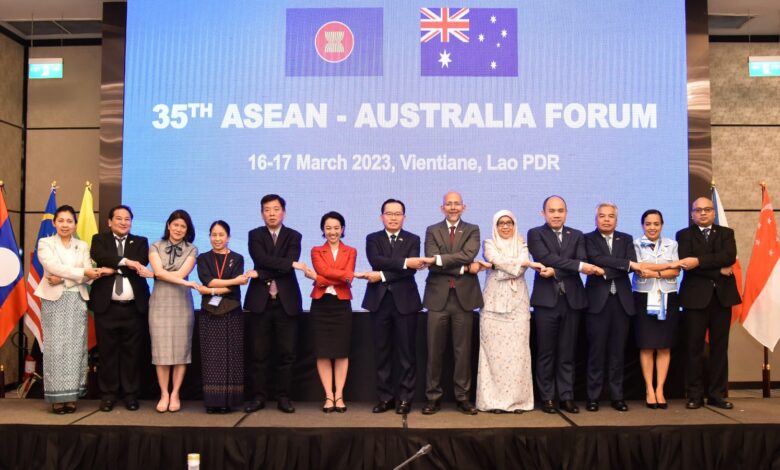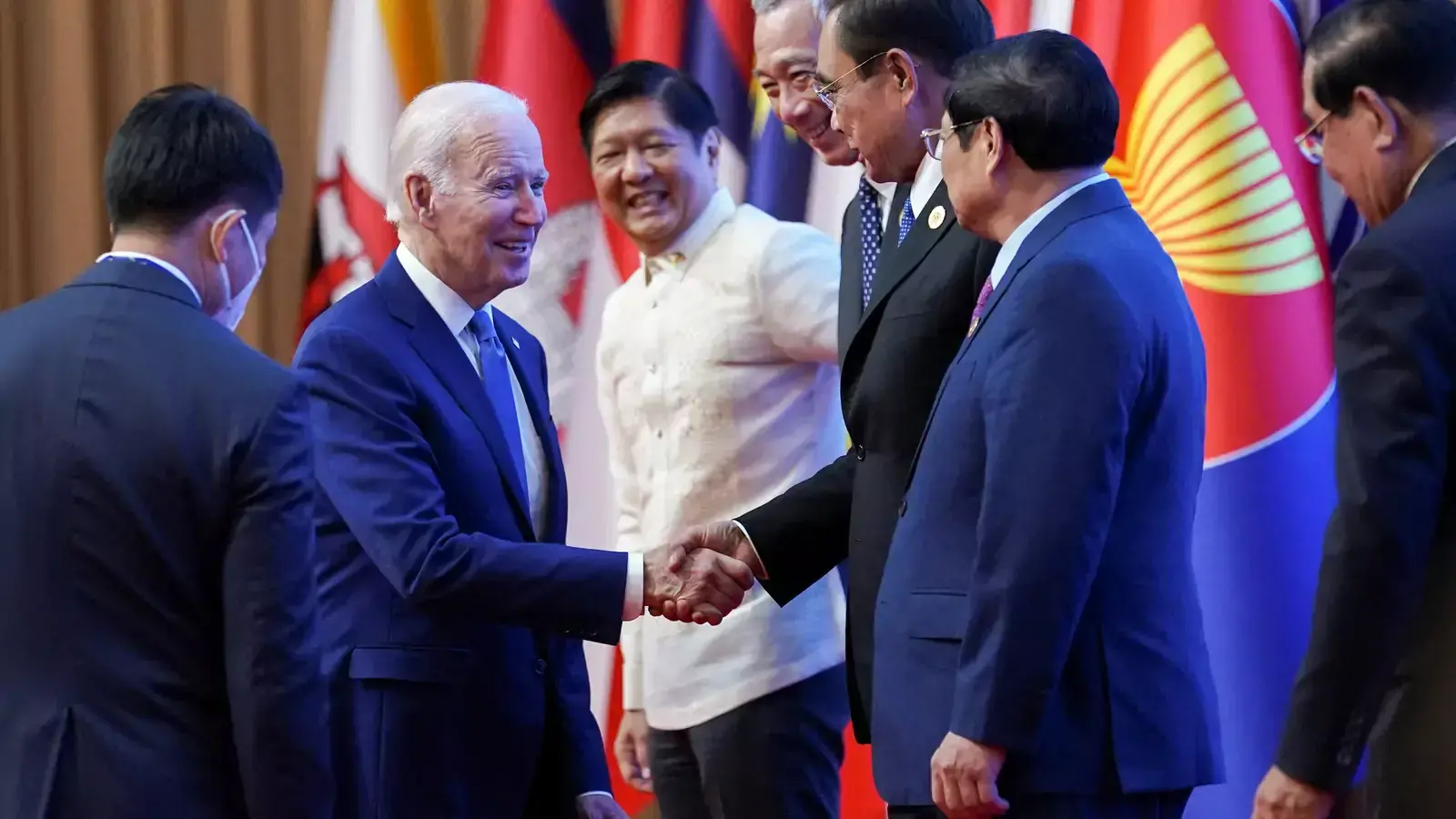Australia’s Move Gives $41mn To ASEAN Countries For ‘Free, Open’ South China Sea; The South China Sea Emerging As The Next Flashpoint In Geopolitical Arena And How Hollywood Is Caught In This Conflict?
Australia's Foreign Minister, Penny Wong, announced a $64 million funding initiative for maritime security on the opening day of a special summit with members of the ASEAN in Melbourne. The summit celebrates 50 years of Australia's partnership with ASEAN, including its alliance with the United States and participation in security agreements like AUKUS. Meanwhile, amidst rising tensions in the South China Sea, Philippine President Ferdinand Marcos Jr delivered a strong message to Australia's parliament, reaffirming his nation's unwavering stance on territorial sovereignty amid ongoing disputes with Beijing over conflicting claims in the region. The South China Sea conflict is a longstanding geopolitical issue mainly involving territorial disputes over various islands, reefs, and waters in the South China Sea region. Several countries lay claim to different parts of the South China Sea, China, in particular, asserts historical claims over most of the sea, demarcated by its controversial Nine-Dash Line, which encircles about 90% of the area. Hence, tensions in the region have escalated due to China's rapid construction and militarization of artificial islands, as well as frequent encounters between Chinese vessels and those of other claimant states

Australia’s Foreign Minister, Penny Wong, announced a funding allocation of 64 million Australian dollars ($41.8m) for maritime security on the inaugural day of a special summit held with members of the Association of Southeast Asian Nations, ASEAN in Melbourne.
Addressing a forum on maritime cooperation on Monday morning, Wong emphasized the significance of oceans, seas, and rivers for livelihoods and commerce in the region, including the importance of free and open sea lanes in the South China Sea.
Although Wong did not specify the recipient countries for the funding, she expressed appreciation for the efforts made by Indonesia, Malaysia, Vietnam, and the Philippines in delineating their maritime boundaries.
Wong stressed that developments in the South China Sea, Taiwan Strait, Mekong subregion, and the broader Indo-Pacific have ramifications for all nations involved, given the interconnectedness of regional security,
The special summit held in Melbourne commemorates 50 years since Australia attained the status of a “dialogue partner” of ASEAN, which includes countries in Southeast Asia. The milestone comes as ASEAN members conducted their inaugural joint military exercises last year.
Australia’s center-left Labor party has consistently pursued closer relations with the Southeast Asian region, recognizing Australia’s geographical proximity to ASEAN countries.

The Geopolitical Connection
Australia’s engagement with regional neighbours and its interests in the South China Sea is also influenced by its close alliance with the United States, the United Kingdom, and the United States security pact known as AUKUS.
Quoting Indonesian President Joko Widodo, Wong emphasized the responsibility to de-escalate tensions, foster dialogue, and bridge regional differences.
Indonesia, alongside Malaysia, is among Australia’s regional allies expressing concerns that Canberra’s investment in nuclear submarines, amounting to tens of billions of dollars, could potentially fuel a nuclear arms race in Southeast Asia and the wider Asia Pacific region.
The Escalating Tension
The South China Sea conflict is a longstanding geopolitical issue primarily involving territorial disputes over various islands, reefs, and waters in the South China Sea region.
This body of water is strategically significant, as it is a vital maritime route for international trade, hosting rich fishing grounds, and is believed to have abundant oil and gas reserves.
Several countries lay claim to different parts of the South China Sea, including China, Vietnam, the Philippines, Malaysia, Brunei, and Taiwan.
China, in particular, asserts historical claims over most of the sea, demarcated by its controversial Nine-Dash Line, which encircles about 90% of the area.
However, it should be noted that this claim is not recognized by international law, including the United Nations Convention on the Law of the Sea (UNCLOS), which establishes Exclusive Economic Zones (EEZs) and territorial waters based on coastal geography.
Tensions in the region have escalated due to China’s rapid construction and militarization of artificial islands, as well as frequent encounters between Chinese vessels and those of other claimant states.
These increasing encounters often involve disputes over fishing rights, resource extraction, and freedom of navigation and the involvement of the United States, which supports the freedom of navigation in the area and conducts regular patrols, has fuelled the conflict further.
Even though efforts have been made to resolve the conflict through diplomatic means, such as negotiations and arbitration, they have been largely ineffective due to the competing territorial claims and the strategic interests of the involved parties.
As a result, the South China Sea remains a hotspot for potential conflict and a significant source of regional instability.

Phillippines Strong Assertion
In a recent address to Australia’s parliament, Philippine President Ferdinand Marcos Jr expressed unwavering resolve regarding his country’s stance on the South China Sea, amidst escalating tensions with Beijing over conflicting territorial claims.
Marcos emphasized his commitment to preserving Philippine sovereignty, adamantly asserting, “I will not tolerate any foreign power’s attempt to seize even an inch of our sovereign territory.”
Citing multiple incidents involving China in the South China Sea, the Philippines has accused its counterpart of engaging in risky manoeuvres, prompting diplomatic protests against Beijing’s actions.
Spotlighting the formidable challenges faced by the Philippines, Marcos affirmed their determination, stating, “Our resolve is as strong as the obstacles we confront; we shall not capitulate.”
While some Australian lawmakers reportedly applauded Marcos’s remarks, Senator Janet Rice publicly questioned his legacy, leading to her expulsion from parliament for displaying a sign denouncing human rights abuses.

The Growing Allies VS China, Flashpoint
As mentioned above, the dispute in the South China Sea has been a longstanding issue among countries, with tensions escalating in recent times.
China’s expansive territorial claims, which include both land parcels and adjacent waters, have sparked dissatisfaction among other claimants such as Vietnam, the Philippines, Taiwan, Malaysia, and Brunei.
Competing claims over islands and various zones in the sea, like the Paracels and the Spratlys, have further complicated the situation.
China has reinforced its claims through activities like island-building and naval patrols. At the same time, the United States has conducted “freedom of navigation” operations near disputed islands, despite maintaining a stance of neutrality in territorial disputes.
Although Japan has no direct stake in the South China Sea, it supports claimants like Vietnam and the Philippines with ships and military equipment, adding to regional dynamics.
The region’s significance lies in its role as a crucial shipping route, with over 21% of global trade passing through these waters in 2016. Additionally, it hosts abundant fishing grounds and potentially rich natural resources.
China’s “nine-dash line” is central to the dispute, which delineates its extensive claims in the area. While China asserts historical backing for its claims, critics argue that its lack of specificity and the absence of coordinates raise questions about the legitimacy of its assertions.
Vietnam disputes China’s historical narrative, asserting its own historical sovereignty over the Paracels and the Spratlys since the 17th century.
The Philippines, citing geographical proximity, lays claim to parts of the Spratly Islands and the Scarborough Shoal.
Malaysia and Brunei also assert territorial claims based on their economic exclusion zones defined by UNCLOS, though Brunei does not claim any of the disputed islands, while Malaysia claims a few islands in the Spratlys.
Serious clashes between Vietnam and China and stand-offs involving the Philippines have occurred in recent decades, reflecting the volatile nature of the dispute.
Hollywood Caught In The Mix
The controversy extends beyond diplomatic exchanges; the most serious trouble in recent decades has flared between Vietnam and China, and there have also been stand-offs between the Philippines and China.
Hence, claimant countries have been banning films depicting contested territorial claims in the South China Sea.
Most recently, Vietnam banned the Barbie film – over its portrayal of a map that includes the nine-dash line; senators in the Philippines also criticized the map’s inclusion in the movie.
Likewise, Korean pop supergroup Blackpink also came under fire in Vietnam in July 2023 after their concert promoter’s website featured a map with Beijing’s nine-dash line.

The Viewpoint
Australia’s recent decision to allocate funding to ASEAN countries for maritime security could potentially heighten tensions in the already volatile South China Sea region.
Australia is indirectly bolstering their capabilities to assert their claims and protect their interests in the disputed waters, by providing financial support to ASEAN nations, which may be perceived as provocative by China.
From China’s perspective, any external involvement in the South China Sea dispute, especially support for rival claimants, is viewed as interference in its internal affairs and a challenge to its sovereignty.
Beijing has consistently opposed outside intervention in the dispute and has accused countries like the United States and Japan of attempting to contain its rise in the region.
Therefore, China could interpret Australia’s move to strengthen maritime security in collaboration with ASEAN as siding with its adversaries and aligning itself with the US-led efforts to counter Chinese influence in the Indo-Pacific.
The move could lead to heightened tensions and potentially escalate the conflict as China may respond assertively to perceived provocations, further militarizing the region and increasing the risk of confrontations.
Moreover, Australia’s decision to support ASEAN countries financially may also strain its bilateral relations with China.
Beijing has significant economic leverage over countries in the region through investments, trade, and infrastructure projects, and any action perceived as challenging China’s interests could result in diplomatic and economic repercussions for Australia, including trade restrictions or diplomatic retaliation.
The Last Bit, while Australia’s intentions to enhance maritime security and promote stability in the South China Sea may be well-meaning, its actions could inadvertently contribute to escalating tensions and worsen the existing flashpoint with China.






